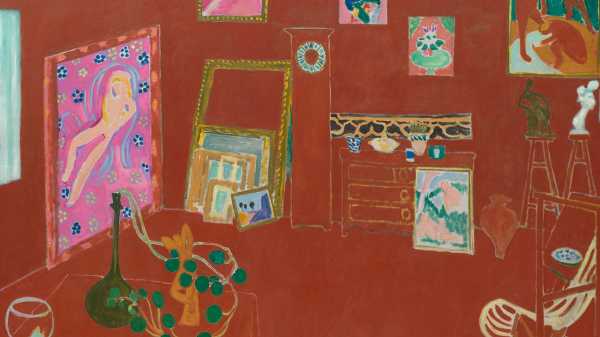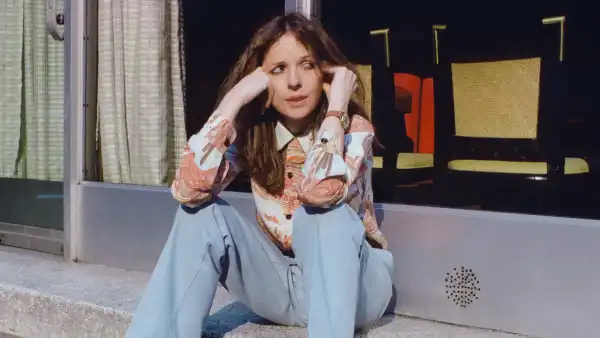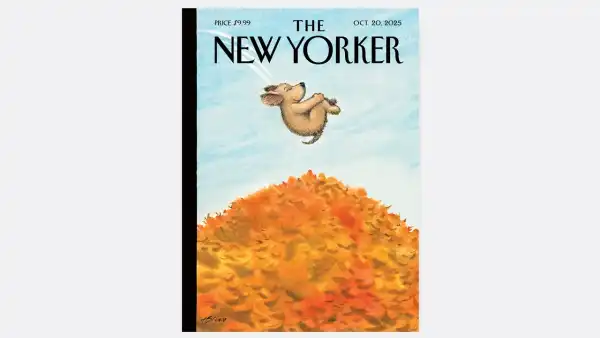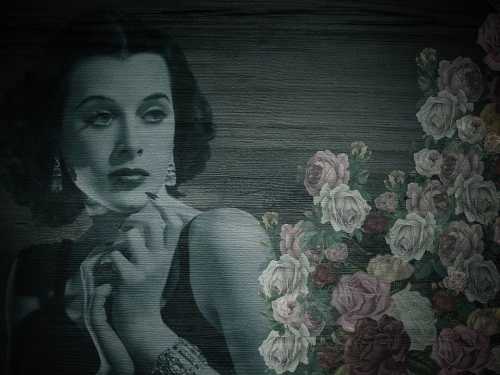
See the two sculptures, both with bad posture, on the far right side of this painting by Henri Matisse? Now, to the right of those, do you see a smudgy, spindly, gray rectangle embedded within a white rectangle? It appears to be affixed to the wall, but, given the wacky perspective in this painting, who knows? Anyway, what is that thing? Credit-card slot? Security camera? Portrait of rigatoni? Miniature Barnett Newman “zip” painting? Early attempt at a stick figure?
I do not know how to conduct a séance, so, in lieu of asking Matisse directly, I posed this question to a bunch of visitors viewing the painting at the Museum of Modern Art, where it’s the focus of the superb eponymous exhibit, “Matisse: The Red Studio.” The exhibit has a “Where’s Waldo?” aspect that encourages you to be a detective. Displayed along with the painting, are, for the first time ever, all existing works of art depicted in the painting. For instance, you can find the real “Le Luxe II” (1907-08), and then see its red clone, painted into “The Red Studio” in 1911. The show includes six paintings, three sculptures, and one ceramic plate. But nothing resembles the bewildering thing, nor are there clues as to what the thing is.
“Light switch” was the going guess, including from the guard standing next to the painting; a woman from Lima, Peru, visiting her son in New York; a tourist from Tokyo, Japan; and two six-and-a-half-year-old cousins in matching green flowery dresses who “don’t just think it’s a light switch, but know it.” I asked Dennis Ashbaugh, a painter who’s had exhibitions at the Whitney and the Met. He argued that, in composing the painting, Matisse needed to balance the picture plane, to keep the right side of the canvas from falling off with a red edge, and to follow the swooping arc of the geometric art on the left wall. “My bet is he was looking for a device to do all of the above, saw a light switch, and said ‘Fuck, I’ll use it,’ ” Ashbaugh said. The second most popular answer was “door handle.”
Other theories include a thermometer, a tool that smoothes paint, a sconce, a bell switch (“you push on it and someone comes running in with more paint”), an inlaid stone top of a side table (“I’d bet my life on it”), a drawing of a pencil, an obelisk, a fragment of a temple or a gatepost, a vertical woven storage basket from some Indigenous people, Matisse’s grocery list (put near the door so he wouldn’t forget it), a vagina, a penis (the two genitalia answers submitted by the same person), a photo of a condom (“obviously”), a perch for his doves, an African mounted sculpture, a mezuzah, a faraway door, or a little window of the variety you might see in a castle that an archer can shoot through. Nadine Orenstein, the head of the drawings and prints department at the Met, recalled that, in Matisse’s “The Pink Studio,” completed several months before “The Red Studio” (same room, different angle, Pepto Bismol-pink floors), there is another rectangle-within-a-rectangle. But here, the inner rectangle is forest green. Could it be a paint swatch? “Maybe he had sample paint colors that he hung on the wall,” Orenstein pondered in an e-mail. (By the way, below that forest-green thing is a smaller unidentifiable object that could be a paint swatch or could be a little framed picture of the Apple logo.)
Ann Temkin, the chief curator of painting and sculpture at MOMA, who spent the past four years putting together this show, should surely know, right? “At the museum, we fondly call this the ‘Mystery Object,’ ” she told me on a private tour of the exhibit. In trying to solve the puzzle, Temkin said, she and her researchers “looked at other paintings to see if there was a comparable item—and yes, there it is, in ‘The Pink Studio.’ ” (As Orenstein had also observed.) Temkin continued, “We also spoke with researchers at the Archives Henri Matisse, who have done a lot of thinking about this, and with two or three of Matisse’s great-grandchildren.”
Hmm. Is it philistine even to speculate? David Apatoff, a lawyer and art critic, thinks so. “Matisse was a great liberator, at the cusp of disconnecting art from content,” he pointed out to me in an e-mail. “He rejected the traditional realism of the Academy to make pictures he called ‘decorations.’ Yet here we are a century later, and scholars are still trying to drag him back, re-connecting his decorations with their subject matter.” Apatoff thought the object was a compositional device. Then he reminded me that Matisse once said, “Whoever wishes to devote himself to painting should begin by cutting out his own tongue.”
Allow me to speak for the tongue. (Orenstein, the curator at the Met, told me, “Nothing is more fun than coming up with ideas about things you know nothing about.”) So what of the light-switch hypothesis? Temkin doesn’t buy it. Matisse moved into the studio in 1909, when he was thirty-nine, before he was Matisse the Famous Painter. The studio was a prefab, customized and commodious but still simple, completed in three months in the Parisian suburb of Issy-les-Moulineaux. Only a handful of photos of that workplace exist. In none is there a light switch. Moreover, light switches at that time were push buttons; they certainly did not look like dimmers. “Might be a drawing or print or photo by him or someone else, distilled,” Temkin concluded, inconclusively.
“It just shows you,” a young woman visiting the exhibit told me, “You have to be careful about what you put on your wall. It could be a painting or it could be a light switch.” ♦
Sourse: newyorker.com






